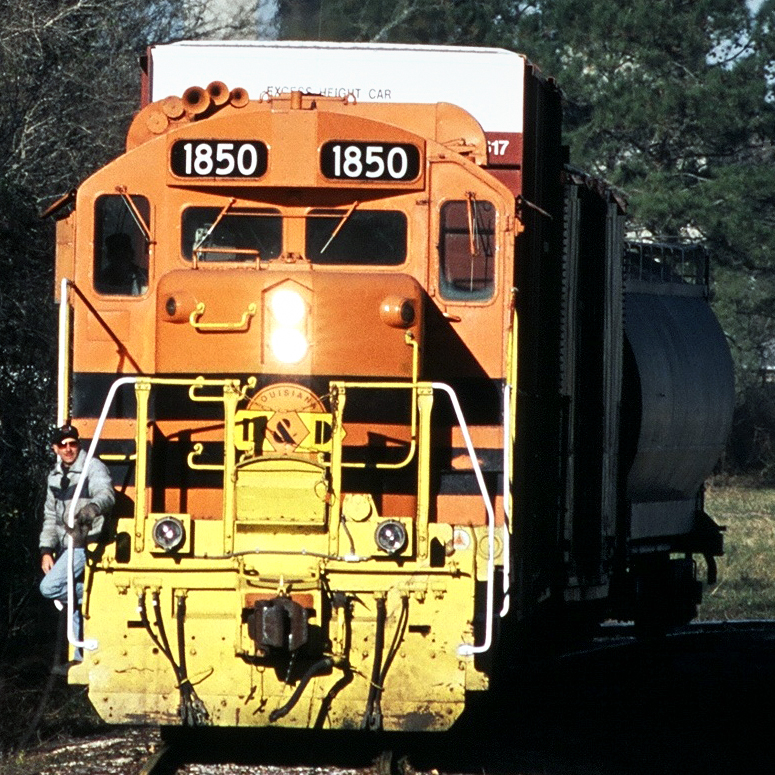In my post of my one scanned 35mm slide from Friday 19 December 2003, I described my personal pattern – and, specifically, the reasons for my personal pattern – of making a gigantic amount of railroad pictures in the two weeks around Christmas and New Year’s Day compared to the rest of the year. Well, that day was the last day of paid work at the day job for 2003; the real holiday started on Saturday 20 December 2003, the first full day off of the 2003 Christmas-New-Year’s break, and that is the day shown here in these few images.
Please keep in mind that all of the images presented in this entire series of 2003-2005 images are scanned 35mm color slides that were scanned before the spring of 2014. There are other slides from that time, and, hopefully, they will be scanned and presented at some point before I die (else, it is extremely unlikely that anyone will ever see them), but they are not shown here and now.
Following the pattern that I had established two weeks to the day before, I went to Morgan City on this morning to continue my explorations of the area. At 08:45, I photographed Louisiana & Delta Railroad train SC1 emerging from the North Boeuf spur with what appears to be three cars.
Hey, that’s Old Man Willie riding the LDRR 1850! Let’s see a cropped version of that image.
Willie went to work for Southern Pacific as a clerk in 1980 and even worked as a station agent, a then-soon-to-be-obsolete dispatching-like role, for a while before going to work as a trainman for the Louisiana & Delta Railroad at about the time of its inception, which is why, even for a trainman, he had a great knowledge of operations and trackage. He retired from railroading in the latter half of 2021, and he was the last railroader in the Houma-Schriever-Thibodaux area to have roots in the area.
Anyway, in Morgan City, at about 09:20, I saw a westbound BNSF Railway train of all hopper cars and tank cars, with BNSF 4785, NS 9155, and MRL 325 as power. This was the first time in my life that I saw a Montana Rail Link locomotive. Also, at first, I thought that this train was a grain train, since the first 15 to 20 cars were old ATSF hopper cars.
Sometime in the following 25 or so minutes, a westbound Union Pacific Railroad manifest train came through with CSXT 739, a very clean EMD SD70MAC, and CSXT 7372, a GE C40, as power. This probably was the MAVBT (Manifest – Avondale, Louisiana, to Beaumont, Texas), since my notes indicate that I later talked on the telephone to Perry in New Iberia who said that this train was making a setout there.) It would not be the last westbound UP train with two CSX locomotives as power that I would see today, and I would get – and present here – an image of the next one!
Before we get to that, though, we have to get to what happened next, which is that the LDRR 1850, after finishing its work at Boeuf and Ursa, continued on westward to New Iberia to get eastbound UP-bound tonnage. Here it is about to cross Berwick Bay, going away from the camera and toward the bridge.
I went back to the house and returned to the track for some afternoon action and found some.
At 14:42, an underpowered westbound UP manifest train – the MNOEW-19 – came through Schriever with 528 axles. It had been hung up on the Lafourche Crossing waiting for the L&D train, which, apparently, had arrived back in Schriever at about this time, to clear its eastbound track warrant.
It had the following power.
CSXT 264 – AC4400CW
CSXT 8186 – SD40-2
These two locomotives, especially the 8186, were putting some serious heat waves above their exhaust stacks.
I decided to try the broadside shot at Chacahoula. Normally, one can’t beat a moving train on the mainline that doesn’t have to stop to close the west siding switch from Schriever to Chacahoula, but I decided I might be able to pull it off today, since he would have trouble getting to full speed, I thought.
I got caught at the red light at Schriever, and it passed me. Normally when this happens, you can give up chase right there altogether. I decided to have a go at it, though.
I put the pedal to the metal and beat him to Chacahoula with good time leftover. The MP 61.4 detector indicated his speed as 30 miles per hour! This was the first time I have ever photographed a train in Schriever then in Chacahoula without it stopping somewhere.
Stay tuned for another quartet of pictures from the same areas, but a yet-to-be-published area east of Schriever, too, from the next day.
Jim




